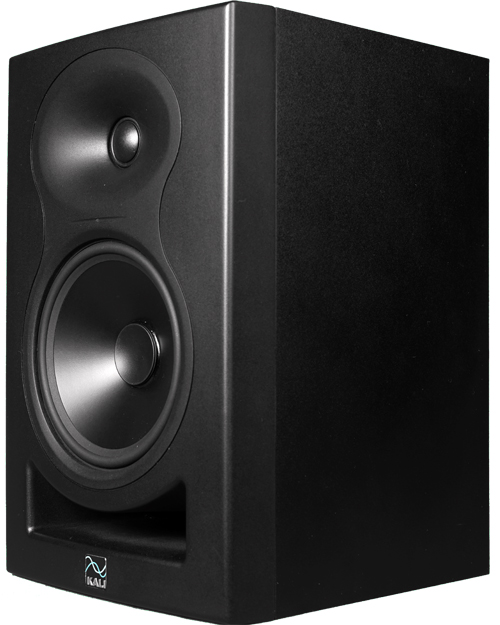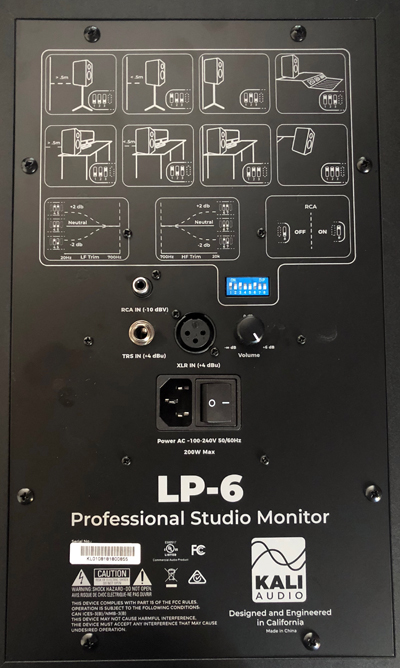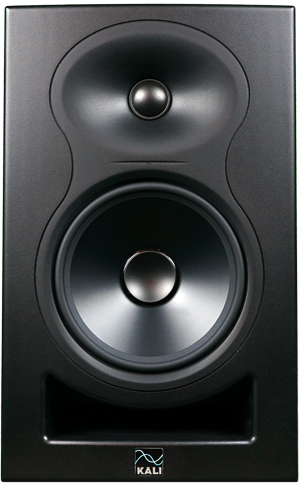|
|
< |
Kali Audio LP-6 Studio Monitors
|
|
|
 |
| Kali Audio LP-6 Monitor |
"LP" is for Lone Pine, a place in the Eastern Sierra and like Apple Computers, Kali names their products after picturesque places in California. The LP-6 starts with quality components, thoughtful design and high technology. It has a 6.5-inch woofer with a two-layer voice coil, large ceramic magnet and a pole vent to reduce noise at high excursions when producing big low frequencies.
A 1-inch soft dome tweeter is set in their "3-D Imaging Waveguide" and is said to match the interaction of the woofer to produce a wider, deeper yet coherent stereo image.
Each driver uses a separate 40-watt Class-D power amp with a protective limiter with fast attack and release timings. Its action is clearly audible when overdriving them--although I did not test this feature. The LP-6's physical size is slightly larger than I've seen in this price range; it measures 14.125 H x 8.75 W x 10.25 D inches and weighs about 15-pounds. The LP-6 is almost half-again deeper than a Yamaha NS-10m yet only slightly taller and wider.
I was glad to see that the LP-6 uses a front reflex port (my preference) that is aerodynamically contoured to minimize "chuffing" port noise--air rushing in and out of the enclosure when reproducing low frequencies. The front of the LP-6 is attractive with the tweeter and it's waveguide above the woofer and the port at the bottom. I liked that Kali chose an overall demurred look and clean finish--it is not overly glossy black and flashy. Important when you are looking at them all day and night mixing. There is a single blue LED power indicator.
The rear panel has connections for: -10dBv level unbalanced RCA jack input, both TRS and XLR jacks for +4dBu, standard world IEC/power on/off switch connector, and a +/- 6dB volume control knob with center-detent. Lastly, there is a single eight-position DIP switch for complete configuration of the LP-6. The LP-6 is delivered with all DIP switches in the down position.
There are complete instructions for setting the switches silk-screened on the back panel--great idea!
Switches 1,2, and 3 are for setting a low Q boundary compensation EQ curves to tailor the monitor's sound predicated upon exactly where and how close to boundaries (walls and desktops) the LP-6 is utilized in your studio. The goal is to bring the speaker back (as close as possible) to its free-field target frequency response as measured in a domestic-size room away from walls (i.e. not anechoic).
 |
| Kali Audio LP-6 Monitor Rear Panel |
Switches 4, 5, 6, and 7 are for user preference settings. These are low and high frequency shelving filters with 0.7 dB per octave from 800Hz down to 100Hz (LF) and from 1.25kHz to 10kHz (HF). These are very subtle and smooth and are a nice touch to personalize your pair of LP-6s just as you'd like. Switch 8 turns on/off the -10dBv RCA input.
In The Studio
My very first use was to set the pair of LP-6 monitors on 5-inch wood plinths on my desktop and on either side of my 29-inch ultra-wide computer monitor. Raising them up can also be done with a pair of Iso-Acoustic mounts--a good idea to keep them from vibrating my desktop--(which they will but it felt cool!). I used the recommended DIP switch settings for desktop placement and connected the LP-6s to the second monitor output on my (calibrated) Crane Song Avocet IIa monitor controller using a pair of XLRs cables.
With the Kalis this close to me, I had the opportunity to check mixes at low volume--always a great idea. I liked what I heard! The Kali Audio LP-6s are spectrally well balanced--not overly bright or dark and they have excellent low frequency presence given their small woofers. Being 36-inches apart on my desktop produced a vivid phantom center image and solid bass--even sub bass notes played in a balanced way. All this is great for most smaller home project studio setups that use small monitors without stands.
 |
| Kali Audio LP-6 Monitor |
I liked the sound of the Kali Audio monitors at the listening position but they blocked the sound coming from my Adams and if I didn't use any other monitors, I'd go with this position.
Next I moved the LP-6s up to an oak shelf that goes between my two Sound Anchor stands. They are in the same position as I have my Yamaha NS10ms on either side of the Adams. I used the wood plinths again and it just happens to work out that LP-6s woofers were the same vertical height as my Adams woofers on Iso-Acoustic Aperta Stands.
With the two pairs of monitors side by side and all in front of me it was easy to use and judge the LP-6s. I was very surprised at how good they sounded. As compared to the larger and more powerful Adams, they held their own with differences in low frequency size (meaning how much they fill the room) and a change in the lower mid-range.
Again, I thought the LP-6s represented the bass very well and I got accurate stereo image albeit constrained by the narrow left/right placement. I played a lot of my mixes as well as CDs and used the Avocet to go back and forth quickly. Musicality translated well between those two systems.
An improvisational Jazz album I have been mixing had an excellent upright bass playing and the LP-6s tracked the dynamics of that instrument easily and cleanly without sounding compressed. The quartet's grand piano sounded smooth and even---I could, of course, solo these instruments in the mix and check them carefully. I would have no trouble mixing music on these monitors!
So a big recommendation for Kali Audio's LP-6 monitors! As a second pair or as a primary pair in budget-minded project rooms, you really cannot go wrong with these!
They sell for $149.99 MSRP.
|
|
|